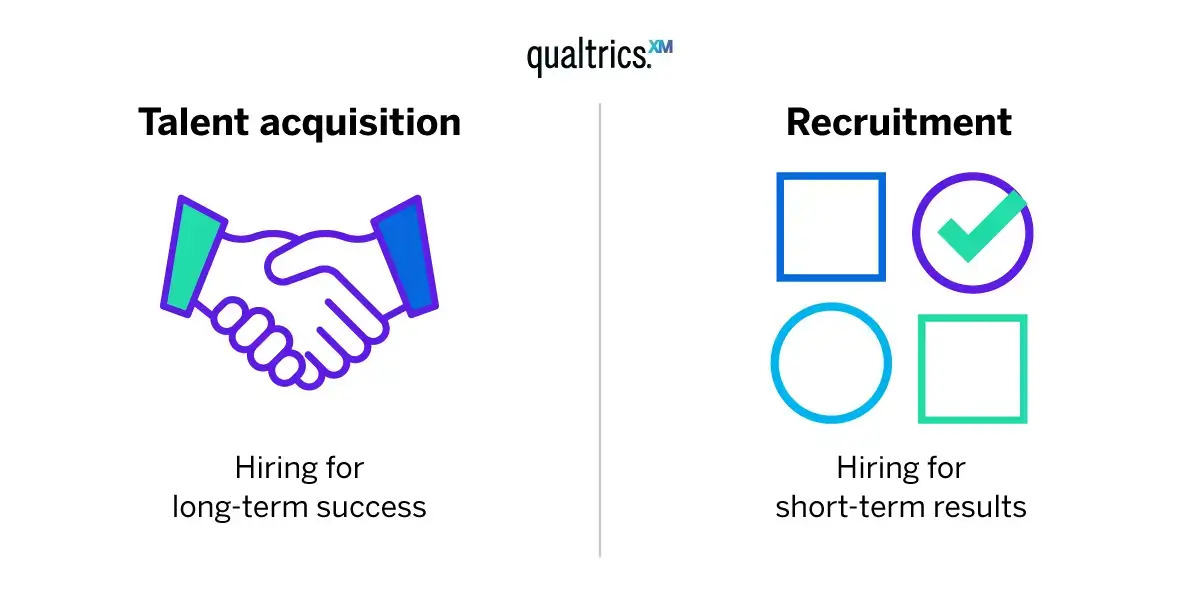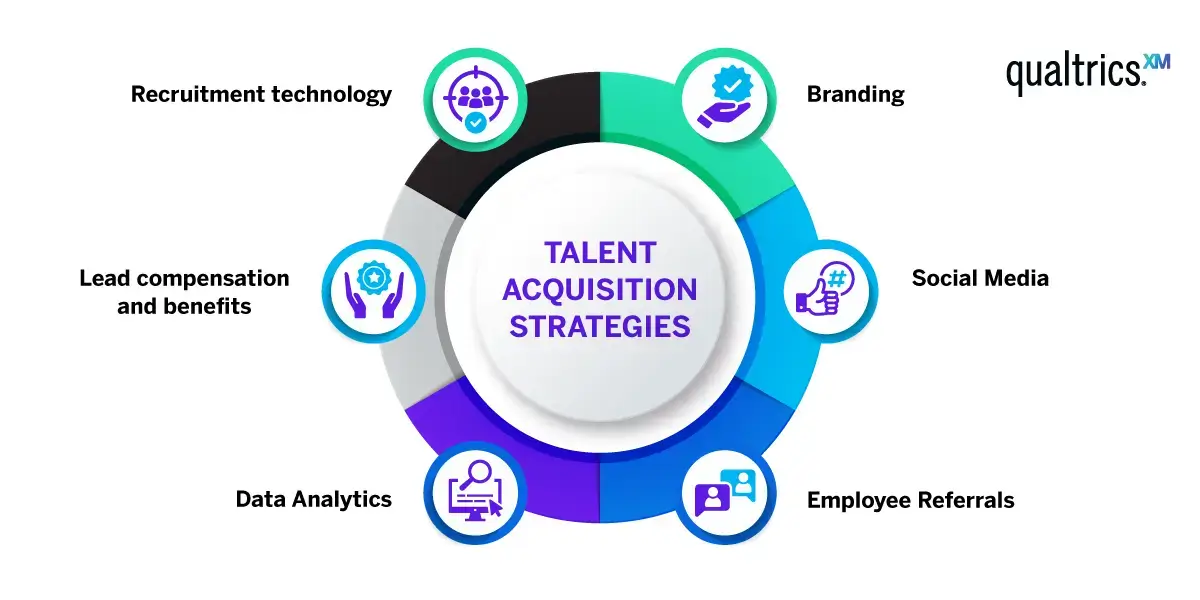Written by: Will Webster
Fact Checked by: Jake Outram
In the fast-paced, ever-changing business world, it will always be essential to attract and retain top talent. Employees are the lifeblood of any organization, and securing high-quality people can be the difference between succeeding in the current challenging economic environment and stagnation and failure.
With the evolving job market, demographic changes and the ever-increasing need for niche skills, talent acquisition remains a key priority for businesses. It not only addresses immediate hiring needs but also ensures organizations are able to navigate uncertainty and prepare for the future.
A successful talent acquisition strategy creates a more robust, future-ready workforce that navigates change and uncertainty and propels the organization toward long-term success. Right now, businesses are implementing a variety of strategies to make that goal a reality.
Before we get into those, let’s start from the beginning.
Control every touchpoint of the candidate experience with Qualtrics
What is talent acquisition?
Talent acquisition is the proactive process of finding, attracting, and hiring skilled people with a long-term view. Whereas traditional recruitment is about filling vacancies and is very focused on the short term, talent acquisition revolves around a deeper understanding of the business’s priorities and goals – both now and in the future.
Focused on talent strategy, crafting a compelling employer brand and building a talent pipeline, talent acquisition is an anticipatory strategy that ensures the organization is prepared to fill key roles with top-notch candidates – reducing hiring lag and ramp time, and promoting business growth.

Why is talent acquisition important?
Talent acquisition plays an integral role in the health and growth of an organization. Here’s why it’s important.
Future-proofing
By forecasting future needs, talent acquisition helps organizations better prepare for the future, ensuring they’re not caught off guard when key roles become vacant.
Quality of hire
Good talent acquisition enhances the quality of candidates brought onboard. With targeted sourcing and thorough vetting, organizations can ensure they hire great talent who make big contributions.
Employer branding
A strong employer brand plays a key role in any effective approach to talent acquisition; in today’s world, it can be the difference when deciding between potential employers for many candidates. It is also important to consider the brand perceptions of employees who have been rejected – would you want them to apply for a similar role in the future, are they current or prospective customers?
Reduced hiring time
Talent acquisition will build and nurture a talent pipeline, which can significantly cut down the time it takes to fill vacancies. Reduced hiring time can promote business continuity and limit productivity loss.
Competitive advantage
Ultimately, the talent within an organization is what sets it apart. Strategic talent acquisition ensures that a company has the people to innovate, help generate growth and outperform competitors.
Talent acquisition vs recruitment

While easily thought of as the same thing, recruitment and talent acquisition are in fact very different.
Recruitment is a shorter-term, reactive process focused on filling immediate vacancies quickly and efficiently. Talent acquisition, on the other hand, is a strategic, long-term approach. Beyond immediate needs, it’s about forecasting future talent requirements, building and nurturing a pool of potential candidates, and improving the company’s brand as an employer.
Talent acquisition often proves to be a better approach for long-term, sustainable business success. This is mainly because it’s focused on preparing the organization for future needs – instead of just responding to current ones – creating a competitive advantage in the job market and maintaining business continuity.
In a nutshell, while recruitment is about filling vacancies, talent acquisition is about building a future-proof workforce. And recruitment, if used correctly, is an important competency within talent acquisition strategy.
What is a talent acquisition strategy?
A talent acquisition strategy is a proactive plan that guides an organization in attracting, hiring and retaining top talent. It can involve workforce planning, which analyzes current and future talent needs, employer branding, employee experience and hiring strategy – including where and how candidates are sourced, and their experience during the selection process.
The end goal of any talent acquisition strategy is to secure the talent that will best enable the organization’s long-term success.
6 common talent acquisition strategies

Businesses today adopt many different approaches – or strategies – within their talent acquisition process. With all talent acquisition strategies, their effectiveness will vary based on the specifics of an organization, the people within it and the industry it sits in.
A single business shouldn’t be applying every talent acquisition strategy, but the businesses that are most effective at it do combine several at once. Here are the most widely used examples.
1. Developing a strong employer brand
An employer brand is essentially your company’s reputation as a place to work, as well as the value you offer to your employees. Helping your company stand out at job fairs and on job boards, it can significantly enhance your ability to attract top-tier talent.
To build your employer brand, start highlighting across various channels what sets your company apart – be it flexible work options, growth opportunities, unique perks or the work environment you’ve created. Authenticity is key, so consider encouraging your employees to share their positive experiences on platforms like Glassdoor or on social media.
2. Leveraging social media
Social media is a powerful tool for pulling back the curtain on the best bits of your business – increasing your visibility and building relationships with potential hires to reinforce your talent acquisition efforts.
Each platform, from LinkedIn to Instagram, can offer unique ways to showcase your company culture, job openings and industry insights. They provide an unparalleled opportunity to regularly engage with your followers by sharing updates, success stories and thought leadership.
3. Investing in employee referrals
Encouraging employee referrals, where your people are rewarded for referring qualified candidates from their networks, can truly leave everyone a winner.
And who better to authentically sell your company than existing employees? As insiders, your people are best placed to understand the company culture and job requirements, making them excellent scouts for potential talent.
A well-structured referral program can not only speed up hiring but often leads to candidates who are a good cultural fit and will stick around for longer.
4. Using data analytics
Incorporating data into your talent acquisition strategy can help streamline and optimize the process.
Data analytics can identify hiring trends through an applicant tracking system, determine the effectiveness of recruitment channels and predict future staffing needs. What you’re then left with is the ability to make evidence-based decisions, allowing your business to recruit more efficiently and effectively.
5. Offering leading compensation and benefits
An attractive salary and benefits package will always set you apart in a competitive job market. But to achieve that you need to make sure you know what “attractive” really means.
You should regularly benchmark your compensation against industry standards and offer benefits that employees truly value – be it flexible working, health benefits, wellbeing perks or opportunities for professional development. As older generations leave the workplace and younger ones enter it, bear in mind that the meaning of attractive benefits is forever changing.
6. Using recruitment technology
Particularly when it comes to your hiring process, there’s no reason why you shouldn’t be leveraging technologies like to create a better experience for all.
Every business should be using dedicated tools to help manage applications efficiently, automate communications with candidates and even assist in the pre-screening stage. Tools for virtual interviews and collaborative hiring can also enhance the hiring experience for both recruiters and candidates.
The power of human-centered talent acquisition
Candidate experience is another key focus area within talent acquisition – not only influencing the quality of your talent attraction and hiring, but also how every job applicant perceives your business and brand. Safe to say, it’s never been more important to ensure a positive experience for all..
Discover how candidate experience management software can assist your employees at every touchpoint of the candidate experience.
Control every touchpoint of the candidate experience with Qualtrics